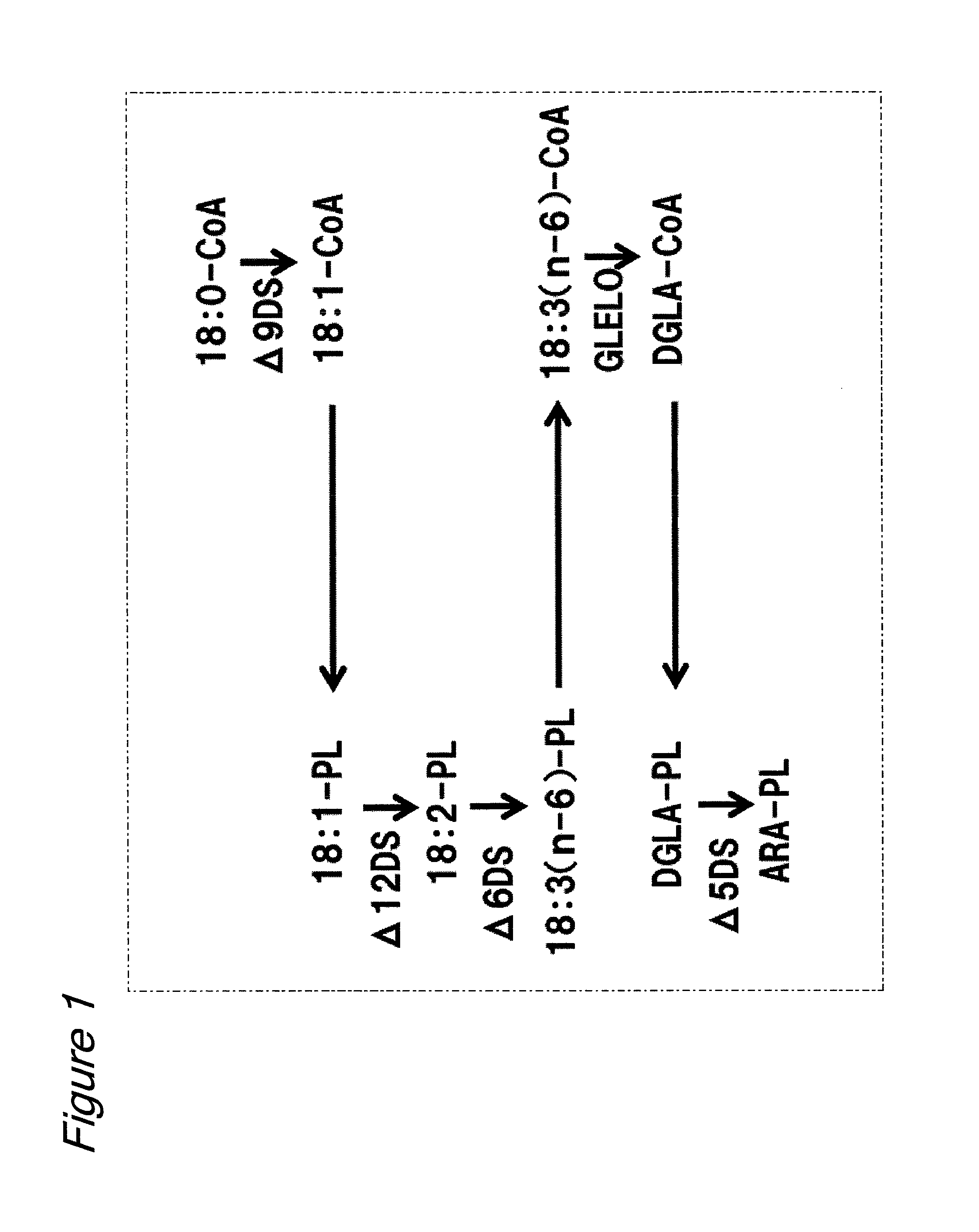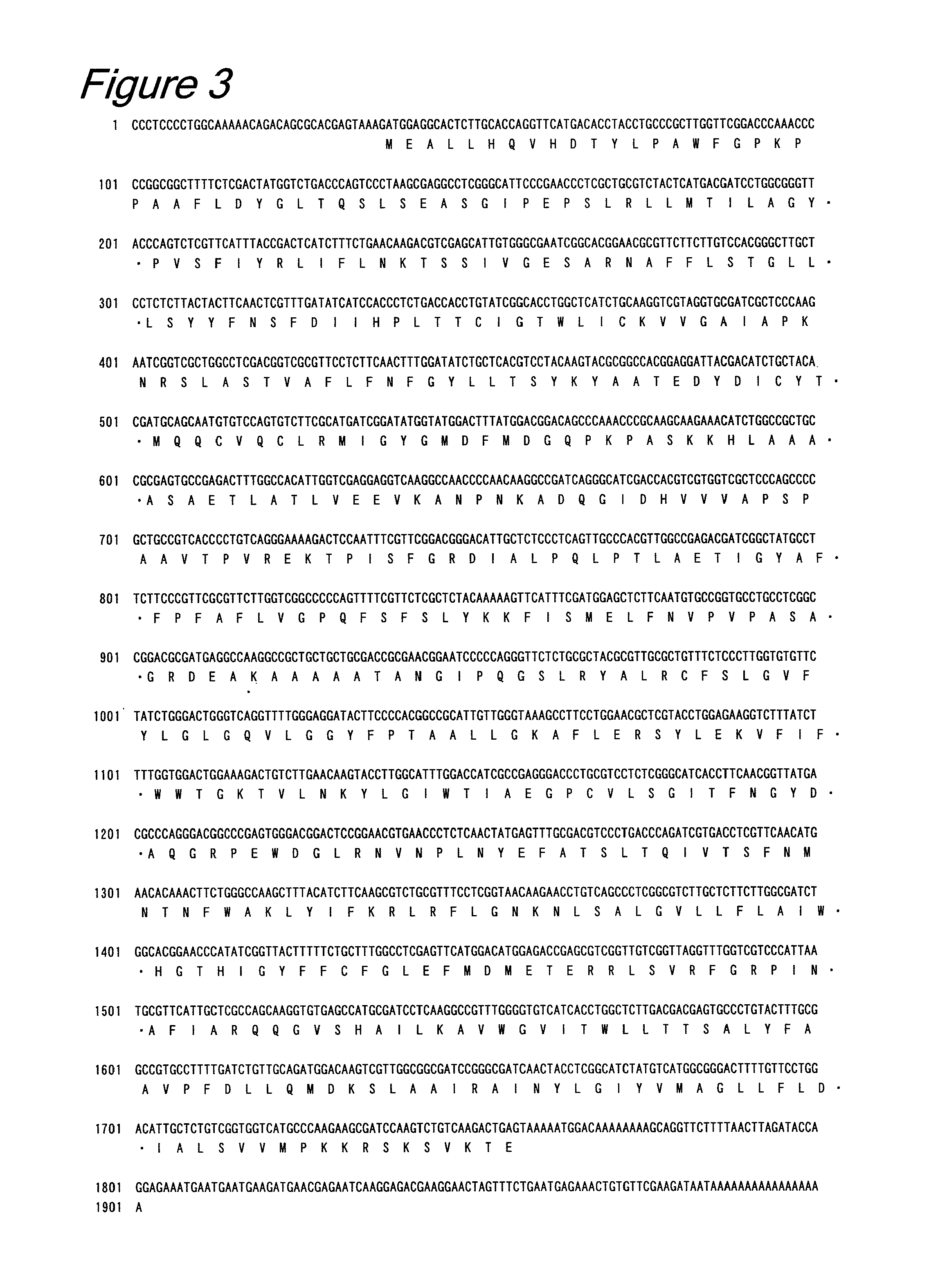Lysophospholipid acyltransferase
a technology of lysophospholipid and acyltransferase, which is applied in the direction of peptides, fatty-oil/fat refining, chemical production of bulk chemicals, etc., can solve the problem that the proportion of pufas in total fatty acids cannot be sufficiently increased, so as to improve the ability to produce fatty acids and improve the productivity of polyunsaturated fatty acids.
- Summary
- Abstract
- Description
- Claims
- Application Information
AI Technical Summary
Benefits of technology
Problems solved by technology
Method used
Image
Examples
example 1
Genomic Analysis of M. Alpina
[0175]M. alpina strain 1S-4 was inoculated into 100 ml of GY2:1 medium (2% glucose, 1% yeast extract, pH 6.0) and cultured with shaking for 2 days at 28° C. The cells were harvested by filtration to prepare genomic DNA using DNeasy (QIAGEN).
[0176]The nucleotide sequence of the genomic DNA was determined using Roche454GS FLX Standard. This involved two runs of fragment library sequence sequencing and three runs of mate pair library sequencing. The resulting nucleotide sequences were assembled into 300 supercontigs.
[0177]Construction of cDNA Libraries
[0178]M. alpina strain 1S-4 was inoculated into 100 ml of a medium (1.8% glucose, 1% yeast extract, pH 6.0) and precultured for 3 days at 28° C. The total amount of the preculture was inoculated into 5 L of a medium (1.8% glucose, 1% soybean powder, 0.1% olive oil, 0.01% Adekanol, 0.3% KH2PO4, 0.1% Na2SO4, 0.05% CaCl2.2H2O, 0.05% MgCl2.6H2O, pH 6.0) in a 10 L culture vessel (Able Co., Tokyo) and incubated wit...
example 2
Construction of Yeast Expression Vectors
[0193]In order to express LPLAT5 and LPLAT6 in yeast, vectors were constructed as follows.
Using pBLPLAT5 as a template, PCR was performed with ExTaq (Takara Bio) and primer Eco-MaLPLAT5-F (SEQ ID NO: 15):
[0194]
GAATTCATGCTAAACTCATTCTTCGGGGACGC
and primer Xho-MaLPLAT5-R(SEQ ID NO: 16):
[0195]
CTCGAGTTACAGCGTCTTGATTTTAACTGCAGC.
[0196]The resulting DNA fragments were TA-cloned using a TOPO-TA cloning Kit (INVITROGEN), and the nucleotide sequence of the insert was determined to give a plasmid having a correct nucleotide sequence designated pCR-LPLAT5. A DNA fragment of about 1.6 kb obtained by digesting this plasmid with restriction endonucleases EcoRI and XhoI was inserted into the EcoRI-SalI site of a yeast expression vector pYE22m (Appl. Microbiol. Biotechnol., 30, 515-520, 1989) to generate plasmid pYE-MALPLAT5.
[0197]On the other hand, a DNA fragment of 1.9 kb obtained by digesting pBLPLAT6 with restriction endonucleases EcoRI and KpnI was inserted...
example 3
Functional Analysis of LPLAT6 in M. alpina
[0225]Construction of Mortierella Expression Vectors
[0226]The following oligonucleotides were synthesized for use as adapters.
[0227]
(SEQ ID NO: 29)A-1: GATCCGGCGCGCCGCGGCCGCTCTAGAGTCGACGGCGCGCCA(SEQ ID NO: 30)A-2: AGCTTGGCGCGCCGTCGACTCTAGAGCGGCCGCGGCGCGCCG.
A-1 and A-2 were annealed and ligated to a fragment obtained by digesting the plasmid pUC18 with restriction endonucleases EcoRI and HindIII to generate pUC18-R.
[0228]Using genomic DNA or a plasmid prepared from M. alpina strain 1S-4 as a template, each DNA fragment was amplified by PCR using ExTaq (Takara Bio) with the following primer set and cloned using TOPO-TA cloning Kit (Invitrogen).
[0229]Specifically, genomic DNA was used as a template to amplify genomic DNA of about 2 kbp containing the URA 5 gene using the primer set:
[0230]
(SEQ ID NO: 31)primer URA5g-F1: GTCGACCATGACAAGTTTGC,and(SEQ ID NO: 32)primer URA5g-R1: GTCGACTGGAAGACGAGCACG;
to amplify the GAPDH promoter of about 0.9 kbp u...
PUM
| Property | Measurement | Unit |
|---|---|---|
| temperatures | aaaaa | aaaaa |
| temperatures | aaaaa | aaaaa |
| temperatures | aaaaa | aaaaa |
Abstract
Description
Claims
Application Information
 Login to View More
Login to View More - R&D
- Intellectual Property
- Life Sciences
- Materials
- Tech Scout
- Unparalleled Data Quality
- Higher Quality Content
- 60% Fewer Hallucinations
Browse by: Latest US Patents, China's latest patents, Technical Efficacy Thesaurus, Application Domain, Technology Topic, Popular Technical Reports.
© 2025 PatSnap. All rights reserved.Legal|Privacy policy|Modern Slavery Act Transparency Statement|Sitemap|About US| Contact US: help@patsnap.com



